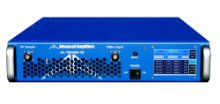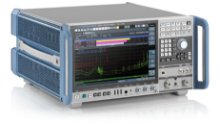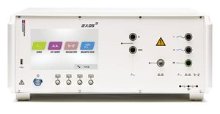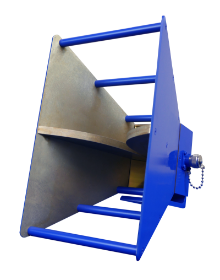What is EMI/EMC Testing?

What is EMC Testing?
ATEC explains what EMC is, the test methods and their standards, and some of the instruments that perform each type of test. Keep reading to learn more.
What is EMC?
Electromagnetic compatibility, commonly referred to as EMC, is a branch of electrical engineering focused on EMI/EMC testing. Jets, gaming systems, and automobiles, for example, all need to be configured to protect against harmful electromagnetic interference, or EMI. Products themselves may also emit electromagnetic interference and must avoid crossing signals. A device which interrupts cell tower signals or damages airplanes could cost companies millions in fines or lawsuits—and such incidents did happen before the consequences of EMI were widely known.For the details on EMI specifically, read our blog What is Electromagnetic Interference?
EMI/EMC Testing Procedure
-
Find the Standards. “Which standards apply to my product?” is the first question you should ask yourself. Varying between product type and geography, standards can be difficult to define or pin down and missing an EMC standard can be disastrous for manufacturers. Contact an EMC lab and determine which standards you need to meet before sending your product in or develop a plan yourself if you’re familiar with the requirements. To do your own research, visit ATEC’s standards page, which will give you detailed outlines of each standard, or contact us for any questions.
- RTCA/DO-160 Standards (Aerospace & Avionics)
- IEC-61000 Standards (Commercial)
- MIL-STD Standards (Military)
- Perform Pre-Compliance Testing. Products must be immune to EMI as well as emit no more energy than regulations require before they are formally tested. Test your devices in full-compliance test sites like anechoic chambers or RF shielded enclosures. Rent full-compliance testers like EMI receivers. Depending on the product being tested, be sure to test for both the product’s immunity to EMI and the emissions it generates, which are discussed in the sections below. Renting fully EMC-compliant test equipment from ATEC will save you money and time in the pre-compliance process—we are ISO-9001 certified and ISO 17025 accredited in calibration by the A2LA.
- Choose an EMC lab. Be sure to choose an EMC lab that is A2LA 17025 accredited. Products intended for commercial sale must be EMC tested, from smartphones to each of the components within. Because of this, EMC labs are busy. Book appointments months in advance and plan out pre-compliance testing to avoid expensive rescheduling.
Test Methods
To assess the EMC of a device or system, technicians perform four types of tests: radiated immunity, radiated emissions, conducted immunity, and conducted emissions.- Radiated Immunity: Analyzes how a device will perform when exposed to the electromagnetic energy it will encounter in its environment.
- Radiated Emissions: Measures the electromagnetic disturbance a device generates. Technicians want to ensure that the product’s emissions are below the relevant limits for its size and power.
- Conducted Immunity: Gauges the response of a piece of equipment to electromagnetic energy that generates within another source and then is conducted along a cable or other conductor to the device under test.
- Conducted Emissions: Measures the level of internal electromagnetic energy which may travel along a conductor and inflict EMI on other systems.
EMC Test Standards
Within the world of EMC, there are many different standards depending on the device under test (DUT). Stricter standards apply to military, aerospace, and automotive DUTs than to commercial. The table below lists some of the most common EMC standards as well as to which fields they apply.| Test Standard | Industry |
| IEC 61000 | Commercial |
| EN | Commercial |
| FCC Part 15 | Commercial |
| CISPR | Commercial |
| MIL-STD | Military/Defense |
| RTCA/DO-160 | Aerospace |
| SAE | Automotive |
| ISO 7637 | Automotive |
EMI/EMC Test Categories
_24.jpg)
Engineers often send their products to be tested and then certified by labs with EMC accreditation. However, according to a report by Intertek Testing Services, roughly 50% of devices fail EMC testing on the first try, causing a potential delay due to having to re-test products. With the products below, you can conduct EMI/EMC testing in-house, running multiple tests to fine-tune your products’ compatibility before sending them to be certified by a lab.
Conducted Emissions Testing
Conducted emissions testing detects the presence of internal emissions of electromagnetic energy, which grow in strength as they are conducted along a power or signal conductor, generating interference. The conductor thus acts as an antenna that is “accidentally transmitting.” Generally, this testing method is applied to simulate internal interference found in power leads and antenna terminals.Below is a diagram of a basic conducted emissions setup.
_25.png)
Conducted Immunity Testing
A conducted immunity test simulates a device’s resistance to external interference generated by a conductor of EMI, like a power or signal cable. Engineers perform conducted immunity testing to discover how the instrument in question reacts to conducted EMI, and how it can be augmented to enhance its immunity.
Below is a diagram of a simple conducted immunity setup.
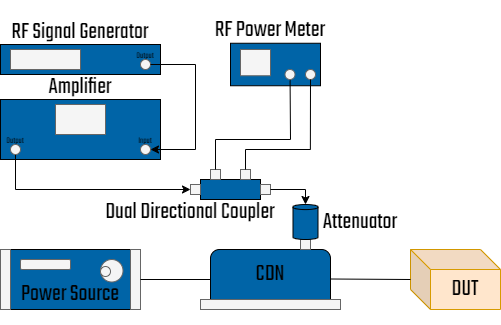
Radiated Emissions Testing
Radiated emissions testing measures the electromagnetic energy a product generates, simulating the interference a device may produce in its environment. Currents and switching voltages within all digital circuits unintentionally generate EMI. The challenge for engineers, then, is to mitigate this interference to the required levels. Radiated emissions testing is conducted either in open area test sites or in anechoic chambers.
Below is a depiction of a typical radiated emissions setup.
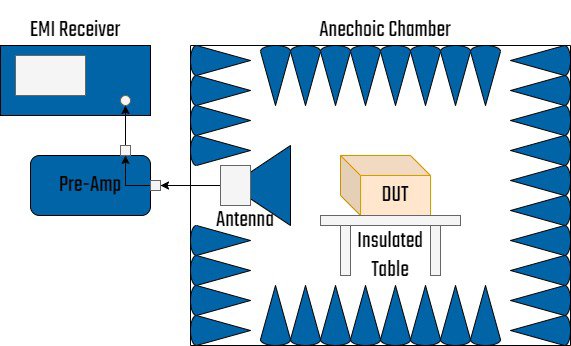
Radiated Immunity Testing
Radiated immunity testing simulates a device’s interactions with other electromagnetic fields it may encounter. Cell phones, radios, motors, and a plethora of other devices may emit EMI that causes damage or interferes with the signal of the device under test. RF amplifiers play an essential role in these tests because to generate an electromagnetic field which effectively mimics conditions for standards, the signal needs precise amplification.Below is a diagram of a standard radiated immunity/susceptibility setup.
_24.png)
Why is EMC Important?

For manufacturers in many fields, testing the electromagnetic qualities of a product is an essential step in production to prevent critical failures down the line. In two particular cases, rogue EMI necessitated more stringent testing. The first, in 1967, happened when an electrical anomaly aboard the USS Forrestal caused artillery to fire and strike a fuel tank, creating a chain reaction of explosions. And in 1993, a passenger's personal CD player interfered with an airplane's autopilot during landing, causing the aircraft to veer off course. Though these incidents occurred decades ago, wireless devices and signals have only become more ubiquitous, and the need for testing is greater than ever.
- Medical Equipment
- If a medical device is unable to function well with the electrical systems around it, the device may pose a risk to patients.
- Military / Aerospace
- Aircraft and other vehicles and instruments may be at risk of emitting or being affected by electromagnetic energy.
- Consumer Goods
- Everything from your iPhone to your laptop and Xbox undergo EMC tests, especially devices which connect to Wi-Fi and have the potential to emit far-reaching EMI.
- Automotive
- Manufacturers of cars and other automotive machines require testing for their components, including parts like engines and radios, as well as the automobiles as a whole. BMW, Mercedes, and Volkswagen are just a few of the car companies with such standards.
- Semiconductors
- Semiconductors are utilized in nearly all computerized products, and due to their capacity for electromagnetic emission, require testing to ensure they don’t interfere with other devices.
The ATEC Advantage
- Largest Inventory: Over $150M in test & measurement equipment stocked in the USA.
- ISO 17025 Calibration: Optional A2LA-accredited certification available on rentals.
- Flexible Rentals: Weekly, bi-weekly, and monthly options.
- Expert Support: Specialists available for guidance.
- Fast Delivery: Same-day shipping for urgent compliance needs.
